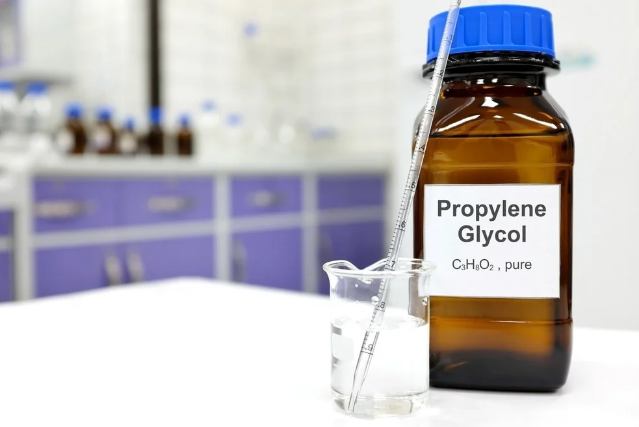Propylene glycol (PG) is a clear, odorless, and slightly viscous liquid with the chemical formula C₃H₈O₂. It belongs to the group of organic compounds known as glycols and is derived from propylene oxide, which is produced from propylene, a byproduct of petroleum refining.
The market research provides industry trends (Drivers, Constraints, Opportunities, Threats, Challenges, and Investment Opportunities), propylene glycol market size, share, and outlook with expert review. Propylene Glycol Market is projected to reach USD 4.7 billion by 2024, at a CAGR of 4.4% from USD 3.8 billion in 2019. The eco-friendly production process of bio-based propylene glycol has led to the growth of the global propylene glycol market. The growing automotive industry in APAC is also driving the market as propylene glycols are widely used in engine coolants and sheet molding compounds, among others.
Propylene glycol has a wide range of applications across various industries due to its unique properties:
- Food and Beverage: PG is used as a food additive and ingredient in various products such as baked goods, confectionery, ice cream, and beverages. It acts as a humectant, solvent, and flavor carrier.
- Pharmaceuticals and Cosmetics: PG is widely used in the pharmaceutical and cosmetic industries as a solvent, preservative, and moisturizing agent in products such as creams, lotions, ointments, and oral medications.
- Personal Care Products: It is found in a variety of personal care products, including soaps, shampoos, deodorants, and toothpaste, where it functions as a moisturizer and humectant.
- Industrial Applications: PG is used as a coolant, heat transfer fluid, and antifreeze agent in industrial processes and systems. It is also employed as a solvent in the production of resins, inks, paints, and coatings.
- E-Cigarettes and Vaping: PG is a common ingredient in e-liquids used in electronic cigarettes and vaping devices, where it acts as a solvent and provides the sensation of a throat hit.
- Animal Feed and Pet Food: It is used as a carrier for flavorings and additives in animal feed and pet food products.
Download PDF Brochure: https://www.marketsandmarkets.com/pdfdownloadNew.asp?id=264488864
Bio-based propylene glycol is expected to have the highest CAGR in the worldwide propylene glycol market, according to market research. Bio-based propylene glycol is made from renewable feedstocks such as biomass or plant-based materials, making it a more sustainable and environmentally friendly alternative to petroleum-based propylene glycol.
The growing demand for environmentally friendly and bio-based products, combined with rigorous environmental regulations, is propelling the rise of bio-based propylene glycol. It is used in a variety of industries, including food and beverage, pharmaceuticals, cosmetics, and personal care, where companies are actively looking for greener options to decrease their carbon footprint and meet consumer demand for eco-friendly products.
Pharmaceuticals are expected to be the fastest-growing application category in the global propylene glycol market during the forecast period. Propylene glycol is becoming more popular in pharmaceutical formulations due to its versatility as a solvent, excipient, and moisturizing ingredient. Propylene glycol improves the solubility and stability of active medicinal components, making it an important component in many medication formulations. Furthermore, the growing emphasis on innovative drug delivery technologies, as well as the requirement for safe and effective pharmaceutical goods, contribute to the rise of propylene glycol in the pharmaceutical industry.
Among end-use industries, the transportation sector is predicted to develop the quickest in the worldwide propylene glycol market during the forecast period. Propylene glycol is widely used in automotive coolants, deicing fluids for aviation, hydraulic and brake fluids, and heat transfer fluids. With advances in vehicle technology, increased demand for energy-efficient solutions, and stringent safety standards, the transportation industry's reliance on propylene glycol is expected to increase. The requirement for efficient heat transmission, corrosion protection, and safe operations in diverse transportation equipment, such as automobiles, aircraft, and industrial gear, is driving this rise.
Inquiry Before Buying: https://www.marketsandmarkets.com/Enquiry_Before_BuyingNew.asp?id=264488864
The Asia Pacific (APAC) region is set to emerge as the fastest-growing market for propylene glycol during the forecast period. With rapid industrialization, a burgeoning population, and expanding end-use industries, APAC presents immense opportunities for propylene glycol manufacturers and suppliers. The region's strong presence in sectors such as automotive, food and beverages, pharmaceuticals, and personal care drives the demand for propylene glycol in various applications. The automotive industry, in particular, is witnessing significant growth in APAC, with rising vehicle production and increasing adoption of advanced cooling systems and antifreeze solutions, which utilize propylene glycol.
The key market players profiled in the report include as The Dow Chemical Company (US), LyondellBasell Industries N.V. (Netherlands), BASF SE (Germany), Archer Daniels Midland Company (US), Global Bio-chem Technology Group Co., Ltd. (China), DuPont Tate & Lyle Bio Products Company, LLC (US), Huntsman Corporation (US), SKC Co., Ltd. (South Korea), Temix Oleo S.R.L. (Italy), and Ineos Oxide (Switzerland).
